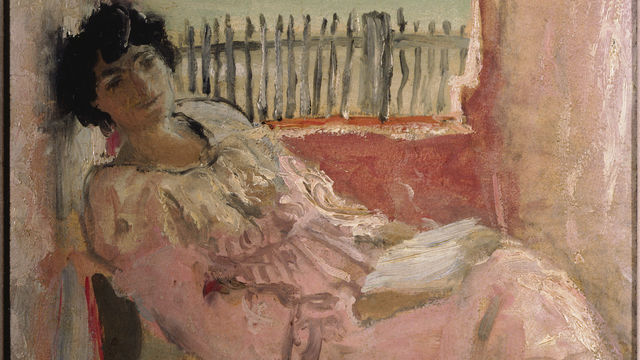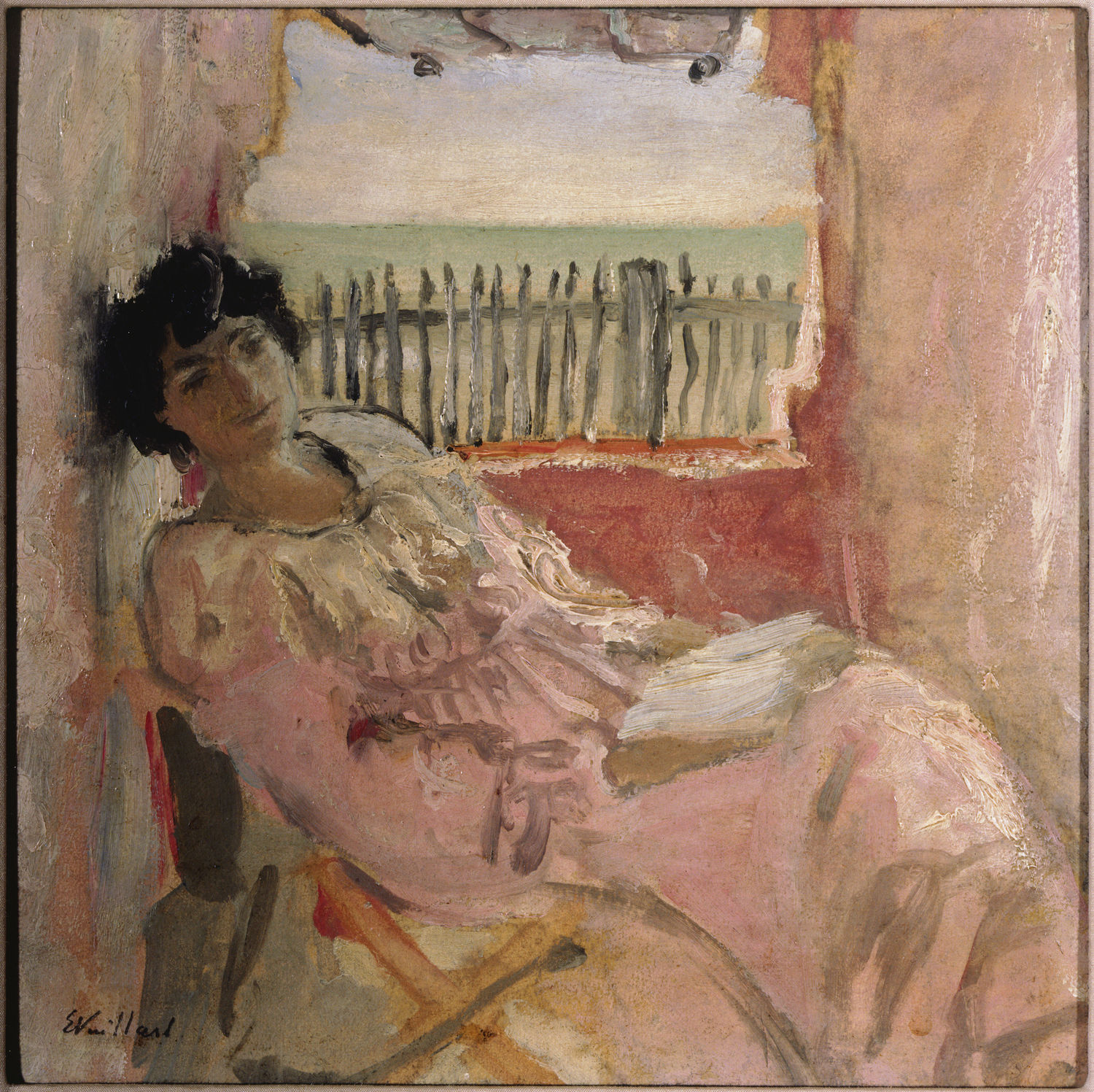
Lunchtime Art Talk Recap: David Rodes on Édouard Vuillard
When I go to an art gallery or museum, I always hope that I will have the patience and the imagination to let the works speak directly to me. But I also love listening in on the lively conversations and arguments that happen between and among works of art. An astute curator will place works in an exhibition to encourage such an interchange of emotion and ideas. Such exchanges seem particularly easy to observe in the intimacy of the Hammer galleries, especially since so many of the works here come from France in the last thirty years of the 19th century.
In my most recent gallery talk, on August 5, I spoke about Toulouse-Lautrec’s Study for “In the Salon on the Rue des Moulins” (1894). Lautrec has affection for the gritty professionalism of his two prostitute, his “ladies in waiting,” but he leaves no illusions about the tedium of their occupation—their very bones seem to have melted into their flesh, even as that sagging skin gives way to the pernicious laws of gravity. The study could well be entitled L’Ennuie—Boredom.

Across the gallery, we see a tiny oil painting of a very different kind of waiting and of a very different class of woman in a work by her admirer, Édouard Vuillard (1868-1940). Madame Hessel at the Seashore, painted about 1904, is a study in grace, lightness, charm, and privilege, and it could well be titled Le Bonheur, which in French not only means “happiness,” but also conveys notions of contentment, satisfaction, and pleasure.
The intimacy of this portrait is conveyed most directly by its small size—just right for a cozy boudoir or a jumbled dressing table. But its tenderness is reinforced by the easeful diagonal angle with which the handsome subject engages and dominates the space. Lucie Hessel looks directly at the painter and then folds us, the viewers, into her dreamy, playful gaze. Her delicate dress is charmingly negligent and fashionable—and its pink color, so near to flesh, suggests a summer holiday of sensual pleasure. The sea beyond is a metonymy for leisure and envelopment.

It should not at all surprise us that Lucie Hessel was the painter’s mistress as well as his muse, their deep friendship lasting from their meeting in 1900 to Vuillard’s death in 1940, fleeing the German invasion of Paris to seek a safe haven in Brittany with his dearest friends, Lucie and Jos Hessel. Theirs is as surely a “French” friendship as is Toulouse-Lautrec’s with his two “ladies” across the room, because Jos Hessel was from 1900 onwards Vuillard’s principal art dealer, securing valuable portrait and decorative arts commissions for his wife’s lover.
Among Vuillard’s more than 660 paintings and pastels, he painted Lucie at least 36 times (by my very rough count in the catalogue raisonné). And this does not include the many drawings and prints he made of her, or the unidentified nudes for which she may well have posed.
A friendship, an inspiration, and an obsession. Vuillard shows her reading, sewing, strolling, shopping, visiting, having a manicure—and in one little pencil sketch of about 1917, talking on the telephone. Meanwhile, I found only one or two portraits of M. Hessel, but he and Lucie offered Vuillard a near lifetime of hospitality at their luxurious apartment on the Rue de Rivoli and at their Chateau de la Claye near Versailles.
When Vuillard was not living with his formidable seamstress mother, which he mainly did until her death when her son was sixty, he was with the Hessels. They had a splendid collection of “modern” art, including works by Cezanne, Renoir, Lautrec, and, of course, Vuillard himself.
Maman et maîtresse were Vuillard’s principal subjects, though he does take us into the salons, gardens, shops, and theaters of Paris, giving us probably the most intimate visual record of the domestic realm in France from1889 to the Second World War. These records include his ambitious sets of prints and his many Kodak photographs, of which some 2,000 remain. For Vuillard, “Domestic routine becomes mystic ritual,” according to one critic.
Vuillard’s career divides roughly into two disproportionate periods: his first decade as a professional artist in the 1890s when he was a founding member of Les Nabis—“the prophets”-who took up their colors and lapidary, often flattened “synthetic” forms from Gaugin, as well as from the craze for Japanese prints and decorative arts that swept Paris from the 1870s onward. About his interlocking compositions—like marquetry in fine furniture or cloisonné in precious objects—Vuillard wrote:
There is a species of emotion particular to painting. There is an effect that results from a certain arrangement of colors, of lights, of shadows. It is what one calls the music of painting…
It is no accident that his mother was a fashionable seamstress who lived amidst a profusion of fabrics and patterns: highly decorative, a bit claustrophobic.
Much of the focus of his second period, the first 40 years of the 20th-century—the period of his relationship with the Hessels, is often seen as simpler and less daring in composition and color. He often devoted his time to lucrative decorative schemes for luxurious houses of his wealthy patrons, as well as to portraits—including Coco Chanel, Jeanne Lanvin, Anna de Noailles, Sacha Guitry, and the music hall star Yvonne Printemps, before Lautrec made her an icon of the demi-monde. Of these works he claimed, “I don’t paint portraits. I put people in their surroundings.”
Many of his patrons, subjects, and friends were Jewish, as well as sophisticated and rich, even though Vuillard himself was raised a humble Catholic boy in the Loire Valley. These relationships serve to remind us just how central Jews were to the intellectual, aesthetic, and commercial life of Paris before the terrible destructions of the 20th century.
Vuillard’s focus on decorative schemes for luxurious dwellings is here represented by the Study for La Place Vintimille of 1909-1910 (but try to see the more extensive display at the Norton Simon Museum through 2/15/2016). Vuillard could have seen this square (now called the Square Berlioz) from his room in his mother’s apartment on the Rue de Calais. The composition is elegantly elongated to emphasize a downward perspective and long view, but it also accommodates the scene to its function as a panel of a fashionable folding screen and wall panel.
There is, of course, much more to say about this painter of the domestic: that he was one of the original contributors, along with Bonnard and Lautrec, to the seminal cultural journal of the 90s, La Revue Blanche; that he designed scenery for avant-garde dramas by Ibsen and Chekov; that before Madame Hessel he mooned, unsuccessfully, over another married women, the spectacularly interesting Misia Sert (then Natanson); that he supported Colonel Dreyfus in the most flagrant case of anti-Semitism and miscarried justice in 19th century France.
But I want to end by invoking the sacred name of Marcel Proust, who called Vuillard “a rare fellow.” Like Proust, Vuillard records the upper-middle-class world of friendships, amours, fashions, and materiality. But Proust soars beyond Vuillard, magically, obsessively transforming the domestic into the epic, dissecting the profound, painful metamorphoses that turned the long, cultured, privileged 19th century into a new, unconstrained century of wars and dying. Maybe the difference involves, on Proust’s part, a much large scale and ambition--and a readiness to be cruel.




